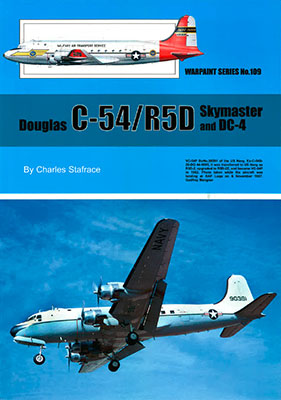
Douglas C-54/R5D Skymaster and DC-4
By Chris Banyai-Riepl
Warpaint Series No 109
Author: Charles Stafrace
Publisher: Guideline Publications
ASIN: B01N1SPDXG
Binding: Softcover
Pages: 280
In the search for bigger, better, and faster, Douglas started on what would ultimately become the DC-4 before the DC-3 had even flown. United Airlines had requested an aircraft with greater capacity and greater range, and it was not long before Pan American, American Airlines, Eastern Airlines, and others also expressed interest in an aircraft capable of flying 2000 miles at a speed of 175mph. Douglas built on the knowledge gained with the DC-3 and created a design that featured triple tails and tricycle landing gear, along with four engines. First flown in 1938, this initial prototype proved to be lackluster in overall performance. This led to Douglas returning to the drawing board and coming up with a simpler, more traditional design that became the classic DC-4/C-54.
Capable of seating 44 (although it could squeeze in up to 86 in an economy configuration), the DC-4 quickly found interested buyers from several airlines. History stepped in, though, and the Japanese attack on Pearl Harbor led the US military to requisition the first nine DC-4s before they could even be delivered to their airline customers, and also took over all the civilian orders on the books. Given the designation C-54, these were no different than the standard DC-4, as necessity dictated that they enter service as soon as possible. The first fully militarized version, the C-54A, added cargo doors to the rear fuselage, and over the years small internal and/or engine changes created the different military variants.
The C-54 (and US Navy R5D) remained in military service in one form or another well into the 1970s, operating in notable situations such as the Berlin Airlift, Antarctic support missions, and as support aircraft for both the USAF Thunderbirds and USN Blue Angels. The C-54 has been used on every continent in the world, and in the air forces of dozens of nations. Post-war, civilian use exploded, and the DC-4 flew passengers all over the world. As larger and faster aircraft took over the passenger role, the DC-4 soldiered on as a freight hauler, a role that one might still be able to find in some corners of the globe.
This title in the Warpaint series provides a solid overview of this venerable passenger/cargo aircraft. To tell the complete story of the Douglas DC-4/C-54 would easily fill a book five times as long as this one, given its long history, but this book does a great job of whetting the appetite. The text covers the development and operational history of the DC-4, with extensive coverage of wartime usage. The post-war coverage is much broader, and therefore not as in-depth as it covers civilian, US military & government, and foreign military usage. Due to the breadth of operators, the synopses of each one is understandably shorter than the more comprehensive WW2 coverage.
Complementing the text are the photos, and the selection presented here definitely highlights just how colorful the C-54 and DC-4 was. Wartime C-54s were fairly boring in their olive drab and neutral gray colors, but post-war military usage brought about lots of fluorescent color usage, white tops, and polished metal. Switching to the international side, some nations camouflaged their C-54s, adding yet another interesting look to the plane. On the civilian side, the DC-4 operated in a heyday of colorful classic designs that featured crisp cheatlines and attractive logos. The photos throughout the book are mostly in color, with some black and white from the earlier days. In addition to the photos, there are dozens of full-color profile illustrations, and a pull-out with scale drawings.
For those looking to dip their feet into the DC-4/C-54 pool, this is a good introduction to the type. Reading through the text will have you interested in seeking out some of the more fascinating anecdotes that undoubtedly abound around the type, and the nice presentation of colors and markings will merely add fuel to that desire. My thanks to Guideline Publications for the review copy.
